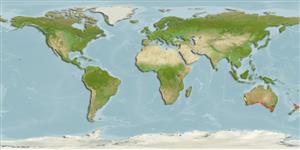इलाज़मौबरांकी (शारक और रेज़) (sharks and rays) >
Myliobatiformes (Stingrays) >
Myliobatidae (Eagle and manta rays)
Etymology: Myliobatis: Greek, mylo = mill + Greek, + Greek, batis,-idos = a ray (Raja sp.) (Ref. 45335).
More on author: Macleay.
Environment: milieu / climate zone / depth range / distribution range
पारिस्थितिकी
समुद्री प्रवाल-भित्ति संयुक्त; गहराई सीमा 1 - 85 m (Ref. 9862). Subtropical; 27°S - 43°S
Eastern Indian Ocean: southern Australia, from Western Australia to Queensland. Possibly occurring off New Zealand.
आकार / वज़न / Age
Maturity: Lm ? range ? - ? cm
Max length : 120 cm WD पुल्लिंग / अलिंग; (Ref. 6871); अधिकतम प्रकाशित वज़न: 56.5 kg (Ref. 40637)
Commonly found off beaches and over sand flats in shallow water. Also found offshore down to 85 m (Ref. 9862). Feeds mainly on crabs and shellfish (Ref. 6871). Ovoviviparous (Ref. 50449).
Life cycle and mating behavior
Maturities | पुनरुत्पत्ति | Spawnings | Egg(s) | Fecundities | लार्वा
Exhibit ovoviparity (aplacental viviparity), with embryos feeding initially on yolk, then receiving additional nourishment from the mother by indirect absorption of uterine fluid enriched with mucus, fat or protein through specialised structures (Ref. 50449).
Last, P.R. and J.D. Stevens, 1994. Sharks and rays of Australia. CSIRO, Australia. 513 p. (Ref. 6871)
IUCN Red List Status (Ref. 130435)
Threat to humans
Venomous
Human uses
आखेट मत्स्य: हां
साधन
Warning: mysqli::__construct(): (HY000/1040): Too many connections in /var/www/html/includes/speciessummary.lib.php on line 2104
Can't connect to MySQL database fbquizv2. Errorcode: Too many connections
